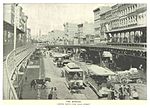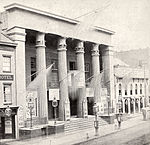Chinese American Bank
1967 establishments in New York City2007 mergers and acquisitionsBanks based in New York CityBanks disestablished in 2007Banks established in 1967 ... and 4 more
Chinese-American culture in New York CityChinese American banksDefunct banks of the United StatesPrivately held companies based in New York City
The Chinese American Bank (Chinese: 中美銀行) was an overseas Chinese bank in the United States headquartered in New York City, with branch offices in Chinatown, Manhattan and in Chinatown, Flushing. The privately owned community bank was established in 1967 to serve the ethnic Chinese in Chinatown. A burgeoning community of Chinese immigrants in the Flushing Chinatown prompted the bank to open another branch there. The Chinese American Bank was acquired by United Commercial Bank in the second quarter of 2007; United Commercial Bank later went defunct and was acquired by East West Bank in November 2009.
Excerpt from the Wikipedia article Chinese American Bank (License: CC BY-SA 3.0, Authors).Chinese American Bank
Bowery, New York Manhattan
Geographical coordinates (GPS) Address Nearby Places Show on map
Geographical coordinates (GPS)
| Latitude | Longitude |
|---|---|
| N 40.716388888889 ° | E -73.995833333333 ° |
Address
Bowery
Bowery
10002 New York, Manhattan
New York, United States
Open on Google Maps





